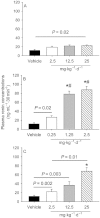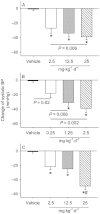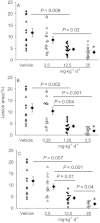Comparative effects of different modes of renin angiotensin system inhibition on hypercholesterolaemia-induced atherosclerosis
- PMID: 22014125
- PMCID: PMC3372847
- DOI: 10.1111/j.1476-5381.2011.01712.x
Comparative effects of different modes of renin angiotensin system inhibition on hypercholesterolaemia-induced atherosclerosis
Abstract
Background and purpose: Inhibition of the renin angiotensin system (RAS) has been consistently demonstrated to reduce atherosclerosis. However, there has been no direct comparison among the three available pharmacological modes of inhibiting the RAS, which are inhibitors of renin, ACE and angiotensin II type 1 receptor. The purpose of this study was to determine the relative effects of these three modes of pharmacological RAS inhibition in reducing atherosclerosis by determining the dose-response relationships.
Experimental approach: Male LDL receptor -/- mice were administered either vehicle or any of three doses of aliskiren, enalapril or losartan through s.c. infusion for 12 weeks. All mice were fed a saturated fat-enriched diet during drug infusions. Systolic and diastolic BPs were measured during the study using a non-invasive tail-cuff system. Plasma cholesterol and renin concentrations, atherosclerotic lesions, and renal angiotensin II concentrations were determined at the termination of the study.
Key results: Plasma renin concentrations were increased by all three drugs. None of the drugs changed plasma cholesterol concentrations. All drugs produced a dose-related decrease in BP. All three drugs also profoundly reduced atherosclerosis in a dose-dependent manner. The highest dose of each drug markedly attenuated lesion size, with no significant differences between the different drugs. The highest dose of each drug also similarly reduced renal angiotensin II concentrations.
Conclusion and implications: Drugs that inhibit the RAS, irrespective of their mode of inhibition, profoundly affect atherosclerotic lesion development in a dose-dependent manner.
© 2011 The Authors. British Journal of Pharmacology © 2011 The British Pharmacological Society.
Figures




Similar articles
-
AT1 antagonism and renin inhibition in mice: pivotal role of targeting angiotensin II in chronic kidney disease.Am J Physiol Renal Physiol. 2012 Oct;303(7):F1037-48. doi: 10.1152/ajprenal.00672.2011. Epub 2012 Jul 11. Am J Physiol Renal Physiol. 2012. PMID: 22791343
-
[The future of renin inhibition].Turk Kardiyol Dern Ars. 2009 Oct;37 Suppl 7:32-8. Turk Kardiyol Dern Ars. 2009. PMID: 20019475 Turkish.
-
Renin inhibition and atherosclerosis.Nephrol Dial Transplant. 2008 Aug;23(8):2474-6. doi: 10.1093/ndt/gfn184. Epub 2008 Apr 22. Nephrol Dial Transplant. 2008. PMID: 18430802 No abstract available.
-
Renin-angiotensin system blocking drugs.J Cardiovasc Pharmacol Ther. 2014 Jan;19(1):14-33. doi: 10.1177/1074248413501018. Epub 2013 Sep 13. J Cardiovasc Pharmacol Ther. 2014. PMID: 24038019 Review.
-
Direct inhibition of renin as a cardiovascular pharmacotherapy: focus on aliskiren.Cardiol Rev. 2007 Sep-Oct;15(5):242-56. doi: 10.1097/CRD.0b013e318093e43a. Cardiol Rev. 2007. PMID: 17700383 Review.
Cited by
-
Manipulation of components of the renin angiotensin system in renal proximal tubules fails to alter atherosclerosis in hypercholesterolemic mice.Front Cardiovasc Med. 2023 Aug 16;10:1250234. doi: 10.3389/fcvm.2023.1250234. eCollection 2023. Front Cardiovasc Med. 2023. PMID: 37655218 Free PMC article.
-
Renin-Angiotensin System and Cardiovascular Functions.Arterioscler Thromb Vasc Biol. 2018 Jul;38(7):e108-e116. doi: 10.1161/ATVBAHA.118.311282. Arterioscler Thromb Vasc Biol. 2018. PMID: 29950386 Free PMC article. Review. No abstract available.
-
Antisense oligonucleotides targeting hepatic angiotensinogen reduce atherosclerosis and liver steatosis in hypercholesterolemic mice.Glob Transl Med. 2023;2(1):288. doi: 10.36922/gtm.288. Epub 2023 Feb 24. Glob Transl Med. 2023. PMID: 37293374 Free PMC article.
-
Cys18-Cys137 disulfide bond in mouse angiotensinogen does not affect AngII-dependent functions in vivo.Hypertension. 2015 Apr;65(4):800-5. doi: 10.1161/HYPERTENSIONAHA.115.05166. Epub 2015 Feb 17. Hypertension. 2015. PMID: 25691624 Free PMC article.
-
PD123319 augments angiotensin II-induced abdominal aortic aneurysms through an AT2 receptor-independent mechanism.PLoS One. 2013 Apr 12;8(4):e61849. doi: 10.1371/journal.pone.0061849. Print 2013. PLoS One. 2013. PMID: 23593499 Free PMC article.
References
-
- Aberg G, Ferrer P. Effects of captopril on atherosclerosis in cynomolgus monkeys. J Cardiovasc Pharmacol. 1990;15:S65–S72. - PubMed
-
- Azizi M, Menard J, Bissery A, Guyenne TT, Bura-Riviere A, Vaidyanathan S, et al. Pharmacologic demonstration of the synergistic effects of a combination of the renin inhibitor aliskiren and the AT1 receptor antagonist valsartan on the angiotensin II-renin feedback interruption. J Am Soc Nephrol. 2004;15:3126–3133. - PubMed
-
- Candido R, Jandeleit-Dahm KA, Cao ZM, Nesteroff SP, Burns WC, Twigg SM, et al. Prevention of accelerated atherosclerosis by angiotensin-converting enzyme inhibition in diabetic apolipoprotein E-deficient mice. Circulation. 2002;106:246–253. - PubMed
-
- Candido R, Allen TJ, Lassila M, Cao Z, Thallas V, Cooper ME, et al. Irbesartan but not amlodipine suppresses diabetes-associated atherosclerosis. Circulation. 2004;109:1536–1542. - PubMed
Publication types
MeSH terms
Substances
Grants and funding
LinkOut - more resources
Full Text Sources
Medical
Molecular Biology Databases
Miscellaneous

